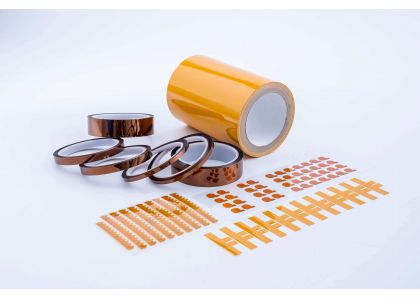
Polyimide tape, often recognized by its brand name Kapton tape, is a highly versatile adhesive solution widely used in various industries due to its exceptional thermal resistance, electrical insulation, and durability. Whether referred to as Kapton, Pi tape, or simply polyimide tape, understanding how to store this tape properly is crucial to maintaining its performance and longevity. Improper storage can lead to degradation or diminished adhesive properties, ultimately impacting the effectiveness of the tape in critical applications.
Before delving into storage practices, it’s essential to clarify what polyimide tape is and its applications. Made from a high-performance thermoplastic polymer, polyimide tape is known for its ability to withstand extreme temperatures, ranging from -269°C to 400°C (-452°F to 752°F). Its high dielectric strength makes it an excellent choice for electrical insulation, while its chemical and dimensional stability ensures it holds up well under various environmental conditions.
Common applications for polyimide tape include:
· Masking during powder coating: Polyimide tape effectively masks components, providing a precise barrier during coating processes.
· Insulation in electronics: It is often used in circuit boards and other electronic devices where heat resistance and electrical insulation are required.
· Aerospace and automotive uses: In these industries, polyimide tape is utilized for its reliability in extreme conditions.
To maintain the integrity and performance of polyimide tape, specific storage conditions should be observed. Here are the key factors to consider:
Polyimide tape should be stored in a controlled environment where the temperature is moderate and stable. Ideally, the temperature should range from 15°C to 25°C (59°F to 77°F). Extreme heat can affect the tape’s adhesive properties, while cold temperatures might lead to brittleness or cohesion issues.
Humidity plays a critical role in the storage of polyimide tape. High humidity can lead to moisture absorption, which may compromise the adhesive's ability to bond effectively. The ideal humidity level for storing polyimide tape should be below 60%. Using a dehumidifier in storage areas can help maintain correct humidity levels, especially in regions where humidity fluctuates significantly.
Exposure to sunlight and other forms of ultraviolet (UV) light can degrade polyimide tape over time. Therefore, it is best to store the tape in a dark or opaque container. Keeping the tape away from direct sunlight not only preserves the material but also prevents any potential chemical reactions caused by UV exposure.
Polyimide tape should be stored in its original packaging whenever possible. The protective layers of the packaging help prevent bending, creasing, or any physical deformation. If the original packaging is not available, use a clean, dry, and anti-static bag. Ensure that the tape is rolled correctly and that the ends stick to themselves or are secured with a suitable non-damaging piece of tape.
When laying polyimide tape flat for storage, make sure the surface is clean, dry, and smooth. Avoid storing tape on rough surfaces or areas where it may be exposed to contaminants. Furthermore, check to ensure that any tools or materials placed near the storage area do not generate dust or particles that could settle on the tape.
In addition to following the recommended conditions, adhering to best practices can help maximize the lifespan of polyimide tape:
Regular Inspections: Conduct regular checks on stored tape to ensure it remains in good condition. Look for signs of damage, such as tears, curling, or changes in color, which may indicate degradation.
Avoid Stacking: When storing multiple rolls of tape, avoid stacking them on top of each other. Stacking can cause pressure points that might lead to deformation or damage. Use shelving to keep rolls upright and separated.
Temperature Logging: Consider using temperature and humidity logging devices to monitor storage conditions continuously. This data can help ensure that environmental factors stay within the desired range.
Limit Inventory: Do not overstock polyimide tape. Having too much inventory can lead to subjecting the tape to varying environmental conditions over time. It is often better to have a smaller inventory that is rotated regularly to ensure freshness.
While polyimide tape, including its Kapton variant, generally benefits from the above storage conditions, specialized applications might require additional considerations:
High-Temperature Applications: For use in high-temperature environments, confirm with the polyimide tape manufacturer about temperature limits and any specific storage requirements related to the material’s formulation.
Compatibility with Other Materials: If you plan to store polyimide tape alongside other adhesives or materials, be aware of any compatibility issues that could arise. Certain materials can leach chemicals that may degrade the polyimide tape.
In conclusion, maintaining the performance and longevity of polyimide tape—whether it's Kapton, Pi tape, or other variants—depends significantly on proper storage conditions. By adhering to recommended temperature and humidity levels, minimizing light exposure, and utilizing appropriate packaging, users can ensure that their polyimide tape remains effective for its intended applications.
Consulting with a polyimide tape manufacturer is also beneficial for understanding specific storage guidelines based on the tape’s intended uses. By implementing these practices, you can protect your investment in polyimide tape, ensuring that it performs reliably in high-demand environments, such as electronics manufacturing, industrial coatings, or aerospace applications. Ultimately, proper storage is key to getting the most out of this versatile and valuable material.